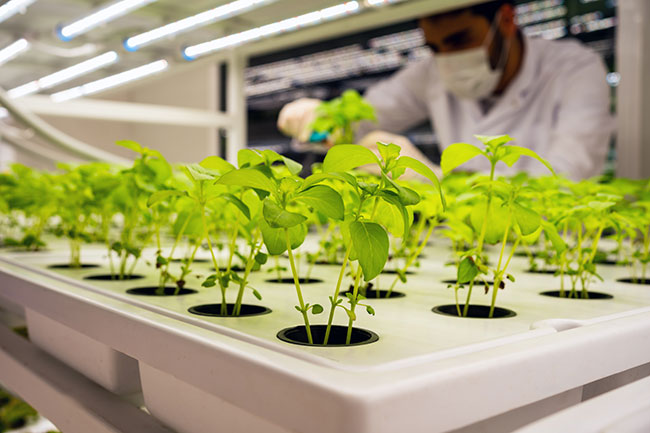
Features
Sowing seeds of unity
Canada’s first professional association for Controlled Environment Agriculture (CEA) is gaining momentum in Alberta
January 19, 2024 By JOHN DIETZ
 PHOTO: Phynart Studio/getty images
PHOTO: Phynart Studio/getty images
It takes a little organizing to grow something but, in Alberta, Canada’s first controlled environment agriculture industry association is getting a good foothold.
The fast-growing sector, known by several names, is quickly becoming a supplier of fresh, locally grown vegetables and fruit. The sector operates year-round, independently of weather, virtually anywhere.
Controlled environment agriculture (CEA) can refer to any type of enclosed crop production. The sector greenhouses, glasshouses, growth chambers, and a variety of indoor farms.
It includes farming methods compatible with closed-spaces or indoor agriculture, such as hydroponics, aeroponics, aquaponics, and vertical farms.
A starting place
Richard Gibson, after more than 30 years in agriculture, is leading the Alberta-based effort to organize a first CEA industry association in Canada.
Gibson, with a penchant for indoor farming, is co-founder of a Calgary vertical farm startup, Planetary Harvest Vertical Farm Inc. He earned a University of Manitoba master’s degree in plant pathology and pursued a career in Alberta.
Working at InnoTech Alberta as a technology development officer for 20 years, he helped others start new companies.
In July 2021, he signed off from his public career to develop his own startup.
Gibson says, “I’ve always been interested in indoor farming. The real game changer over the last decade or so has been LED lighting.
“Technologies just keep getting better. Now, plants are starting to be developed specifically for indoor farming. Finally, the future really looks like what we were thinking back during the moon landings.”
Along with architectural technologist RC (Chuck) Smith, Gibson co-founded Planetary Harvest, with a mission is to develop vertical farms that combine simple technologies with clean industrial design for northern, arctic, and subarctic climates.
“We’re looking at how we can take some of the complexity out of vertical farming,” he says.
Planetary Harvest, at this point, is building a prototype for testing simplified vertical farm designs.
While going down the road to build their own CEA design company, Gibson and Smith needed information, supplies, and and other various kinds of help.
Gibson soon discovered that there were hidden pockets of CEA suppliers, academics, government offices, organizations, and a few established vertical or indoor farms.
This diverse group of CEA stakeholders shared similar beliefs in the potential for significant local fresh food production, but they weren’t connected.
Gibson realized, a collective voice for the specific interests of the vertical farming sector was missing. And, wasn’t alone. By a chance meeting with Olds College, he found they had already been contemplating the need for a united CEA sector.
With that, the seed was planted for an Alberta CEA association.
CEA Alberta Association
In early summer, 2023, with encouragement from Olds College and CEA stakeholders, Gibson took on the role of coordinating Alberta-based efforts to organize the first provincial CEA industry association in Canada.
They would call it: The Controlled Environment Agriculture Association of Alberta (CEA3).
By October, he says, a structure and set of five board members had been selected. A website was launched, and approval from the Alberta Registry for the new association was pending.
About 30 individuals and companies lined up for memberships in advance of the official registration, he says. Most are from Calgary and nearby areas of southern Alberta. Most are growers; a few are suppliers to CEA growers. Government organizations and departments are expressing interest.
The CEA sector in Alberta ranges in size from single shipping containers to a planned multimillion-dollar facility in Calgary with dozens of employees.
“We have quite a bit of interest and that’s just based on word of mouth,” he says.
“I’m anticipating that we’ll have quite a bit more interest once people are able to find out about the association. And, it will be easier to communicate once we have the CEA3.ca website running!”
The CEA3 will help advance the indoor farming sector as a complement to local greenhouse production.
“It’s a food production continuum,” Gibson explains.
“We’re in that space where it’s all indoor farming. With some exceptions, we don’t use the sun at all. Still, we have common goals with the greenhouse industry, like local food production and creation of local jobs.”
Coming down the pipe, after registration, will be a focus on funding specific CEA research projects to help de-risk investments into the sector at a very early stage. Many funding agencies do not support vertical farming yet.
“The association will be a clearinghouse for information for people who want to learn about the industry, how to get started in it, and tap into the network,” he says.
“The main driver for me is creating opportunities for people to work. I love working in agriculture and this is really exciting. Indoor farming actually is the next step for agriculture in Alberta, and that’s my main passion, getting people to have rewarding jobs and careers.”
Pivotal stakeholders
Pivotal stakeholders in the association-to-be include Olds College in Olds, Alberta, and Dr. Saied Mobini, Queen’s University horticulturist and Phytotron manager in Kingston, Ont.
As a response to many requests for information about CEA-type farming over a few years, Olds College “initiated the concept of an association” around Spring 2022, says Todd Ormann, Vice-President, Development.
Before CEA came along, he explains, Olds College already had well-established and well-developed programs supporting farming and the greenhouse industry.
With the great advances in technology and rapidly growing interest in indoor farming without sunlight, the college developed plans to start an academic program specifically for the CEA industry. That new program is expected to launch in September 2024.
Ormann says, “It came to a point that we wanted to have an association, to be honest, so we could have a conversation with industry about how we could develop programming and research for CEA.
“Informally last year, I got four or five startups around the table and started mapping out what a controlled environmental ag association would look like and what the role could be. That’s when we brought Richard into the conversation, to finalize and put it together,” Ormann says.
He adds, “It was pretty clear that the idea was well-liked, so Richard has been finalizing the pieces to get the CEA3 off the ground. My hope is that this coming year we can formalize the association.”
The association is being registered in Alberta, but the fresh produce industry and the companies that support it are scattered across Canada. Some are in Alberta, some are not, but the need for associations to represent the industry clearly is national.
“We’ll see where it goes, but we’re not really limiting the scope of it. It may become national, in time,” Ormann says. “Right now, the membership is very Alberta focused.”
Former Alberta horticultural scientist Dr Saied Mobini, now with Queen’s University, has been watching from the sidelines and is supporting the Alberta effort. Mobini, as a student, scientist, and grower, has been involved in greenhouse and CEA production since 1990 in Alberta, Saskatchewan, Ontario, and Quebec.
Mobini has worked internationally, as well, and is a member of the international Association of Vertical Farming which began in Munich, Germany, in 2013.
“As far as I know, there is one other small group for Ontario that is working together” for a similar purpose, Mobini says. “Many people want to get involved. Myself, as a grower, I know the challenges and what they suffer. Communication and transferring knowledge is very, very important.”
An association, Mobini explains, can help growers find the best supplier with the best price, and sell their produce for the highest market value.
It can also fight and advocate for the industry as well as identify supporting regulations and funding available to greenhouse growers for the vertical growers.
“You cannot imagine how big the frustration was for me, a year ago, because Health Canada told me that none of the pesticides and fungicides approved for greenhouses can be applied for vertical farming,” he recalls.
Mobini was involved with several CEA projects in Alberta, as well as across Canada, and saw frustration on both sides of the table. County officials didn’t have experience with vertical farming applications; applicants didn’t have appropriate regulations fitted to their industry.
Mobini says, “I can see a big demand for a vertical farming association in Canada to help and support vertical farming production and operation. It’s not just for Albertans. All the people across Canada need to support this.”
Print this page

